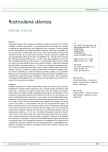Effect of endoscopic and classic surgery for carpal tunnel syndrom
Authors:
M. Kanta 1; E. Ehler 2; J. Kremláček 3; D. Laštovička 1; J. Adamkov 1; S. Řehák 1; J. Habalová 1; M. Bartoš 1
Authors‘ workplace:
Neurochirurgická klinika, LF UK a FN Hradec Králové
1; Neurologické oddělení, Pardubická krajská nemocnice, a. s
2; Ústav patologické fyziologie, LF UK, Hradec Králové
3
Published in:
Cesk Slov Neurol N 2008; 71/104(2): 173-179
Category:
Original Paper
Overview
Objective:
The aim of the study was to compare the results of classic and endoscopic methods of carpal tunnel syndrome surgery.
Patient group and methodology:
29 endoscopically operated patients with mild or medium severe carpal tunnel syndrome, in which the carpal tunnel pressure was peroperatively measured using a Codman sensor (group 1), were statistically compared with an identical number of patients who had traditional surgery (group 2). The following EMG parameters were assessed preoperatively and 3 months after surgery: DML, A-CMAP, A-SNAP, SCV. Also evaluated was patient satisfaction, the presence of post-operative pain 3 months post-op, the time to complete hand function recovery, and the length of sickness disability.
Results:
Both groups presented with similar clinical and electrophysiological findings. A significant postoperative improvement in DML, ASNAP a SCV values was recorded. (p < 0.001) in both the groups. Improvement in ACMAP was only recorded for group 2 (p < 0.001). A significant difference between the two groups was recorded for this parameter in favour of group 2 (p < 0.05). Although conduction velocity increases occurred in both groups, the change in SCV in group 1 was statistically more significant (p < 0.05). Subjective patients’ ratings were significantly better in group 1 (satisfaction p < 0.01, post-operative pain p < 0.001, full hand function recovery p < 0.01, length of sickness disability p < 0.01).
Conclusions:
Based on EMG findings, results of endoscopic carpal tunnel syndrome surgery are fully comparable with those of traditional techniques in patients with mild to medium form of carpal tunnel syndrome. The only difference consists in an ACMAP increase (more for the traditional approach) and SCV (for the endoscopic approach). Endoscopic surgery had better results in terms of post-operative pain, full hand function recovery and subsequent return to work.
Key words:
carpal tunnel syndrome – uniportal endocsopic technique – intracarpal pressure measurement – traditional technique – electrophysiological tests – subjective evaluation
Sources
1. Uchiyama S, Toriumi H, Nakagawa H, Kamimura M, Ischigaki N, Miyasaka T. Postoperative nerve conduction changes after open and endoscopic carpal tunnel release. Clin Neurophysiol 2002; 113 : 64–70.
2. Jimenez DF, Gibbs SR, Clapper AT. Endoscopic treatment of carpal tunnel syndrome: a critical review. J Neurosurg 1998; 88 : 817–826.
3. Nagaoka M, Nagao S, Matsuzaki H. Endoscopic carpal tunnel release in the elderly. Minim Invasive Neurosurg 2006; 49 : 216–219.
4. Dufek J. Návrh jednotného postupu elektrodiagnostiky syndromu karpálního tunelu pro pracovní lékařství. Pracov Lék 2000; 52 : 104–106.
5. Riggans S, England JD. Diseases of the nerves in the shoulder girdle and upper limb. In: Kimura J. Peripheral nerve diseases. Handbook of clinical neurophysiology. Vol 7. Edinburgh: Elsevier 2006 : 841–858.
6. Conrad B, Bischoff C, Benecke R. Das EMG - Buch. Stuttgart: Thieme 1998.
7. McLaughlin MR, Pizzi FJ. „Sympathy pains“ in carpal tunnel syndrome. Acta Neurochir (Wien) 1996; 138 : 1094–1098.
8. Vossen S, Moehlen-Albrecht S, Steffens KJ. Nachoperationen nach endoskopisch voroperiertem Karpaltunnelsyndrom. Handchir Mikrochir Plasti Chir 2007; 39 : 293–297.
9. Brief R, Brief LP. Endoscopic carpal tunnel release: report of 146 cases. Mt Sinai J Med 2000; 67 : 274–277.
10. Kanta M, Ehler E, Laštovička D, Daňková C, Adamkov J, Řehák S. Možnosti chirurgické léčby syndromu karpálního tunelu. Neurol pro praxi 2006; 3 : 153–157.
11. Bahou YG. Carpal tunnel syndrome: a series observed at Jordan University Hospital (JUH), June 1999-December 2000. Clin Neurol Neurosurg 2002; 104 : 49–53.
12. Jablecki CK, Andary MT, So YT, Wilkins DE, Williams FH. Literature review of the usefulness of nerve conduction studies and electromyography for the evaluation of patients with carpal tunnel syndrome. AAEM Quality Assurance Committee. Muscle Nerve 1993; 16 : 1392–1414.
13. Bland JD. Do nerve conduction studies predict the outcome of carpal tunnel decompression? Muscle Nerve 2001; 24 : 936–940.
14. Prick JJ, Blaauw G, Vredeveld JW, Oosterloo SJ. Results of carpal tunnel release. Eur J Neurol 2003; 10 : 733–736.
15. Kanta M, Ehler E, Kremláček J, Laštovička D, Adamkov J, Řehák S et al. Využití měření tlaků v karpálním tunelu během operace syndromu karpálního tunelu. Rozhl Chir 2007; 86 : 588–592.
16. Werner RA, Jacobson JA, Jamadar DA. Influence of body mass index on median nerve function, carpal canal pressure, and cross-sectional area of the median nerve. Muscle Nerve 2004; 30 : 481–485.
17. Werner RA, Andary M. Carpal tunnel syndrome: pathophysiology and clinical neurophysiology. Clin Neurophysiol 2002; 113 : 1373–1381.
18. Beekman R, Visser LH. Sonography in the diagnosis of carpal tunnel syndrome: a critical review of the literature. Muscle Nerve 2003; 27 : 26–33.
19. Weber RA, Sanders WE. Flexor carpi radialis approach for carpal tunnel release. J Hand Surg [Am]1997; 22 : 120–126.
20. Brown RA, Gelberman RH, Seiler JG et al. Carpal tunnel release. A prospective, randomized assessment of open and endoscopic methods. J Bone Joint Surg Am 1993; 75 : 1265–1275.
21. Chow JC, Hantes ME. Endoscopic carpal tunnel release: thirteen years' experience with the Chow technique. J Hand Surg [Am] 2002; 27 : 1011–1018.
22. Stewart JD. Focal peripheral neuropathies. 3rd ed. Philadelphia: Lippincott Williams & Wilkins 2000.
23. Mailänder P, Berger A. Differentialindikation „offene“ oder „endoskopische“ Carpaltunnelspaltung. Chirurg 1997; 68 : 1106–1111.
Labels
Paediatric neurology Neurosurgery NeurologyArticle was published in
Czech and Slovak Neurology and Neurosurgery

2008 Issue 2
Most read in this issue
- Multiple sclerosis
- Hemangioblastoma and its treatment using Leksell Gamma Knife
- Smith-Magenis syndrome: a case report
- Treatment Results of Low-Grade Gliomas in Children (a Retrospective Data Analysis)
